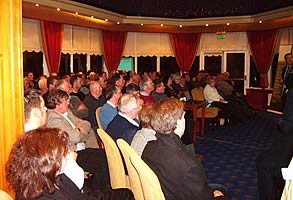 |
|||||||||
|
|||||||||||||||||||
|
|
Increased Incentive for More Green Power Over 80 people attended a seminar on rural issues hosted by H&H Bowe in Lockerbie last week. Attendees who included farmers, local residents and businesses shared the common aim of finding out more about how they could benefit from creating their own renewable energy. The event was held on the very day that the government announced its intentions on Renewable Heat Incentive (RHI) payments which added to the excitement about these opportunities.
Alistair Fell, the company’s Energy Specialist started the evening by reviewing the financial and practical implications not only of wind turbines but also hydroelectric schemes, anaerobic digestion, solar power, biomass and ground and air source heat pumps. Commenting he said: “Inevitably there was a lot of interest in wind turbines particularly as university led research has started to open up new possibilities using different types and models to suit different scenarios. However there was also a lot of interest in potential hydro schemes which is something that may have been previously overlooked but that people are now keen to explore.” Earlier in the day, the government announced the publication of a policy document setting out the details of the RHI which will support technologies including biomass, ground source and water source heat pumps, solar thermal and biomethane. There was substantial interest in the RHI grants with farmers and owners of local woodland who are keen to install biomass boilers wanting to know how they can benefit from potential new grants. Alistair’s initial reaction to the announcement was very positive, “The RHI Premium Payment idea seems like a good one, effectively the scheme is a capital grant to aid uptake which should start in July this year. The actual RHI payments will not commence until October 2012, this is probably a result of greater government caution following the oversubscription to the Feed In Tariffs currently available for green electricity. It would have been nice if the domestic side of things could come on line before next year but it is a step in the right direction and the document also includes proposed tariffs for larger commercial installations which are very welcome. The market place will undoubtedly be wary of committing funds until things are finalised, but overall I would expect to see a big growth in the biomass and wood fuel industry in the coming year as it becomes increasingly attractive for businesses and commercial premises to cut fuel bills by installing biomass boilers. In general, the future looks bright for renewable heat technology providers and this will undoubtedly create jobs.” Other attendees were keen to find out more about utilising solar PV and thermal power. They were particularly interested in the talk by Chartered Town Planner, Neil Henderson from H&H Bowe who, as part of his presentation on the complex planning issues associated with renewable technologies, announced the new permitted development rights for renewables in Scotland including solar for agricultural buildings. To round off the evening, Senior Agricultural Advisor Andy Dyer, from H&H Bowe and Graham Cooke from SEERAD, covered the Single Payment Scheme, Cross Compliance, Environmental Stewardship and how current policy and future developments will impact on Scottish Farming Businesses.
|
||||||||||||||||||

|
|
||||||||||||||||||
| home | agri-services | pedigree
pen | news | dairy | beef | machinery BPS | property | organisations | site map |
|||||||||||||||||||

